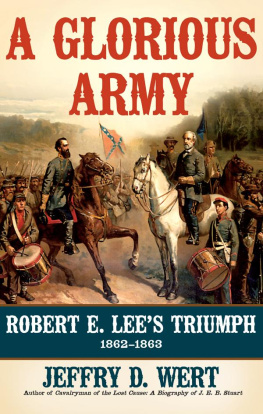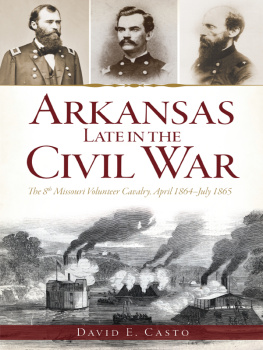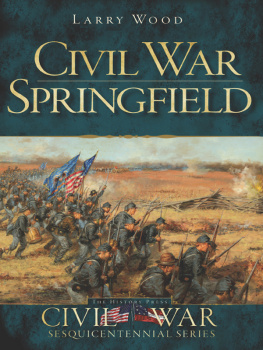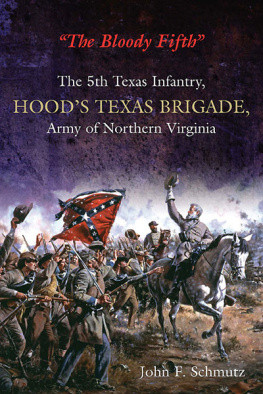
Published by The History Press
Charleston, SC 29403
www.historypress.net
Copyright 2012 by James R. Knight
All rights reserved
Cover: On the Battery, Andy Thomas, artist, Carthage, Missouri,
www.andythomas.com.
First published 2012
e-book edition 2012
ISBN 978.1.61423.357.2
Library of Congress Cataloging-in-Publication Data
Knight, James R., 1945
The Battle of Pea Ridge : the Civil War fight for the Ozarks / James R. Knight.
pages cm. -- (History Press Civil War sesquicentennial series)
Includes bibliographical references and index.
print edition ISBN 978-1-60949-447-6
1. Pea Ridge, Battle of, Ark., 1862. I. Title.
E473.17.K58 2012
973.731--dc23
2011051847
Notice: The information in this book is true and complete to the best of our knowledge. It is offered without guarantee on the part of the author or The History Press. The author and The History Press disclaim all liability in connection with the use of this book.
All rights reserved. No part of this book may be reproduced or transmitted in any form whatsoever without prior written permission from the publisher except in the case of brief quotations embodied in critical articles and reviews.
Dedicated to my great-grandfather, Third Sergeant James R. Knight, Company I, Fourth Arkansas Infantry (CSA), who marched into the Ozarks with Earl Van Dorn, walked back over the Boston Mountains to the Arkansas River Valley after the battle was lost and lived to tell the tale.
Contents
Preface
This book, my third contribution to The History Presss Civil War Sesquicentennial Series, is the most personal. I grew up in northwest Arkansas about seventy-five miles from the Pea Ridge Battlefield. My paternal greatgrandfather and namesake, to whom it is dedicated, was in the Fourth Arkansas Infantry (CSA), which fought in Morgans Woods. When the Confederates retreated back to the camps along Frog Bayou, some of them occupied land farmed by my maternal great-great-grandfatherland on which my mother still lives. He later enlisted in the Confederate army and was with General John S. Marmaduke at Prairie Grove.
Although many sources were used, the foundation for this story is a benchmark work on the Pea Ridge Campaign, Pea Ridge: Civil War Campaign in the West, by William L. Shea and Earl J. Hess. Professor Shea was very kind in encouraging me to go forward with this work and in answering questions along the way. His and Mr. Hesss work is referenced in my notes many times, but it should be understood that, even if not specifically noted, their work continually informed my understanding of the events as nothing else could. Without their work, this book would never have happened.
The other critical source for this work was Hal Jespersen, who created a new series of maps for the book. In a campaign and battle as complex as Pea Ridge, good maps are essential for the reader to follow the action. Without Hals agreement to work with me, I probably wouldnt have taken on the project. Its safe to say that he exceeded all of my expectations. Thanks, Hal, for your skill and patience.
Finally, every military historian knows that nothing can take the place of walking the ground. My thanks to the staff at Pea Ridge National Military Park and Chief Interpreter Troy Banzhaf, who took several hours to show me the battlefield that, in many ways, is little changed from that time 150 years ago.
As always, thanks to Doug Bostick and the folks at The History Press for giving an old history geek one more chance.
Prologue
To make a reputation and serve my country conspicuouslyor fail.
Earl Van Dorn
Pocahontas, Arkansas
February 22, 1862
Headquarters, Trans-Mississippi District No. 2
Major General Earl Van Dorn (CSA) commanding
On this morning, the commander of all Confederate forces in Louisiana north of the Red River, as well as Arkansas, Indian Territory and most of Missouri, sat in his headquarters in this little northeast Arkansas town planning his grand offensive to march north the following month and capture St. Louis. To most observers, Earl Van Dorn would have seemed the very picture of mid-nineteenth-century southern manhoodthe cultured gentleman, the dashing cavalier and the natural-born warrior all rolled into one. At five-foot-eight, with sandy hair and piercing blue eyes, he made a strong impression on the men he commanded, as well as on the many beautiful women who crossed his patha fact that was not at all lost on him. Consequently, he had a well-earned reputation as an aggressivesome would say rashcommander, as well as something of a ladies man.
Earl Van Dorn was born in Port Gibson, Mississippi, on September 17, 1820, the fourth of nine children of Peter and Sophia Van Dorn. Growing up as a son of the plantation aristocracy, he was superbly connected both socially and politically to the antebellum southern power structure. Jefferson Davis, the future Confederate president, was a neighbor and family friend, and when eighteen-year-old Earl decided that he wanted to be a soldier, he received an at large appointment to West Point for the class beginning in the summer of 1838, arranged by his great-uncle, former president Andrew Jackson.
Although he graduated from West Point in the summer of 1842, Buck Van Dorn, as he was known to his classmates, had not been a model cadet, placing fourth from the bottom of his class of fifty-six but still two places ahead of another cadet bound for great things: James Longstreet of Georgia. All told, Van Dorns class would eventually produce seventeen general officers for one side or the other in the coming Civil War. Van Dorn had served with some distinction as a junior officer in the Mexican-America War, but unlike many of his fellow West Pointers who had resigned for more lucrative jobs in the civilian world after the war, Van Dorn stayed on. Now, as the new Confederate departmental commander, he could look back on almost twenty years of military service.
For the last few years before the Civil War, Van Dorn had served mainly in Texas with the famous Second Cavalry, commanded by Albert S. Johnston and then Robert E. Lee. Combat on the frontier in the years leading up to the war usually meant protecting settlers, staging small unit raids on villages and chasing roaming bands of Indians whose first instinct was to scatter and run. Van Dorn had several encounters with Comanches and was once seriously wounded by arrows, so his personal courage was never in doubt. The problem with bringing that kind of combat experience to the current conflict, however, was that the forces opposing him in the Civil War seldom fought like Indians, and his own army of foot soldiers, artillery and supply wagons could seldom live off the land or be maneuvered like a troop of frontier cavalry.
When the state of Mississippi seceded in January 1861, there was no doubt where Earl Van Dorns allegiances lay. He resigned from the U.S. Army, went back home and was immediately commissioned one of four brigadier generals of the Mississippi Militia, but he didnt intend to stay there. By March, he had traded his militia rank for a colonels commission in the regular Confederate army, and because of his prior service there, he was sent back to Texas to try and recruit men from the Federal forces still in the state. By September, Van Dorn was back in Richmond, where his old friend, Jefferson Davis, commissioned him a major general and sent him to command a division in Joseph E. Johnstons Army of the Potomac. Even though he was now a major general, being in an army with two full generalsP.G.T. Beauregard and Johnstonmeant that Van Dorn was still a second-tier player, but that changed when he was ordered back to Richmond in early January 1862 and given command of the Trans- Mississippi Department.
Next page











